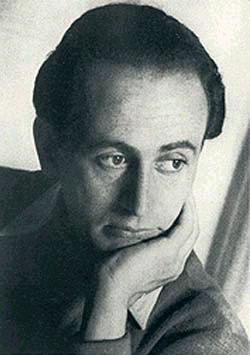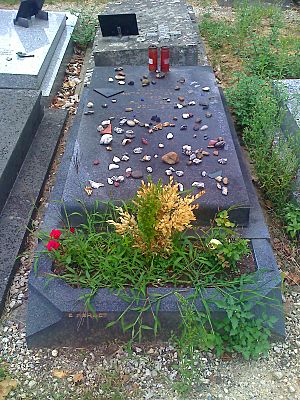Paul Celan facts for kids
Quick facts for kids
Paul Celan
|
|
|---|---|
 |
|
| Born | Paul Antschel 23 November 1920 Cernăuți, Kingdom of Romania (now Chernivtsi, Ukraine) |
| Died | 20 April 1970 (aged 49) Paris, France |
| Occupation | Writer |
| Language | German |
| Nationality | Romanian, French |
| Genre | Poetry, translation |
| Notable works | "Todesfuge" |
| Spouse | Gisèle Lestrange |
| Partner | Ingeborg Bachmann |
| Signature | |
Paul Celan (/ˈsɛlæn/; German: [ˈtseːlaːn]; 23 November 1920 – c. 20 April 1970) was a Romanian-born German-language poet and translator. He was born as Paul Antschel to a Jewish family in Cernăuți (German: Czernowitz), in the then Kingdom of Romania (now Chernivtsi, Ukraine), and adopted the pseudonym "Paul Celan". He became one of the major German-language poets of the post-World War II era.
Contents
Life
Early life
Celan was born into a German-speaking Jewish family in Cernăuți, Bukovina, a region then part of Romania and earlier part of the Austro-Hungarian Empire (when his birthplace was known as Czernowitz). His first home was in the Wassilkogasse in Cernăuți. His father, Leo Antschel, was a Zionist who advocated his son's education in Hebrew at the Jewish school Safah Ivriah (meaning the Hebrew language).
Celan's mother, Fritzi, was an avid reader of German literature who insisted German be the language of the house. In his teens Celan became active in Jewish Socialist organizations and fostered support for the Republican cause in the Spanish Civil War. His earliest known poem is titled Mother's Day 1938.
Paul attended the Liceul Ortodox de Băieți No. 1 (Boys' Orthodox Secondary School No. 1) from 1930 until 1935, Liceul de Băieți No. 2 în Cernăuți (Boys' Secondary School No. 2 in Cernăuți) from 1935 to 1936, followed by the Liceul Marele Voievod Mihai (Great Prince Mihai Preparatory School, now Chernivtsi School No. 5), where he studied from 1936 until graduating in 1938. At this time Celan secretly began to write poetry.
In 1938 Celan traveled to Tours, France, to study medicine. The Anschluss precluded his study in Vienna, and Romanian schools were harder to get into due to the newly imposed Jewish quota. His journey to France took him through Berlin as the events of Kristallnacht unfolded, and also introduced him to his uncle, Bruno Schrager, who was later among the French detainees murdered at Birkenau. Celan returned to Cernăuți in 1939 to study literature and Romance languages.
Life during World War II
Following the Soviet occupation of Bukovina in June 1940, deportations to Siberia started. A year later, following the reconquest by Romania, Nazi Germany and the then-fascist Romanian regime brought ghettos, internment, and forced labour (see Romania in World War II).
On arrival in Cernăuți in July 1941, the German SS Einsatzkommando and their Romanian allies set the city's Great Synagogue on fire. In October, the Romanians deported a large number of Jews after forcing them into a ghetto, where Celan translated Shakespeare's sonnets and continued to write his own poetry. Before the ghetto was dissolved in the fall of that year, Celan was pressed into labor, first clearing the debris of a demolished post office, and then gathering and destroying Russian books.
The local mayor, Traian Popovici, strove to mitigate the harsh circumstances, until the governor of Bukovina had the Jews rounded up and deported, starting on a Saturday night in June 1942. Celan hoped to convince his parents to leave the country so as to escape certain persecution. While Celan was away from home, on 21 June 1942, his parents were taken from their home and sent by train to an internment camp in Transnistria Governorate, where two-thirds of the deportees eventually perished. Celan's father likely perished of typhus and his mother was shot after being exhausted by forced labour. Later that year, after being taken to a labour camp in Romania, Celan would receive reports of his parents' deaths.
Celan remained imprisoned in a work-camp until February 1944, when the Red Army's advance forced the Romanians to abandon the camps, whereupon he returned to Cernăuți shortly before the Soviets returned. There, he worked briefly as a nurse in the mental hospital. Friends from this period recall Celan expressing immense guilt over his separation from his parents, whom he had tried to convince to go into hiding prior to the deportations, shortly before their deaths.
Life after the war
Considering emigration to Palestine, Celan left Cernăuți in 1945 for Bucharest, where he remained until 1947. He was active in the Jewish literary community as both a translator of Russian literature into Romanian, and as a poet, publishing his work under a variety of pseudonyms. The literary scene of the time was richly populated with surrealists – Gellu Naum, Ilarie Voronca, Gherasim Luca, Paul Păun, and Dolfi Trost – and it was in this period that Celan developed pseudonyms both for himself and his friends, including the one he took as his pen name. Here he also met with the poets Rose Ausländer and Immanuel Weissglas, elements of whose works he would reuse in his poem "Todesfuge" (1944–45).
A version of Celan's poem "Todesfuge" appeared as "Tangoul Morții" ("Death Tango") in a Romanian translation of May 1947. Additional remarks were published explaining that the dancing and musical performances evoked in the poem were images of realities of the extermination camp life.
Emigration and Paris years
Upon the emergence of the communist regime in Romania, Celan fled Romania for Vienna, Austria. It was there that he befriended Ingeborg Bachmann, who had just completed a dissertation on Martin Heidegger. Facing a city divided between occupying powers and with little resemblance to the mythic capital it once was, which had harboured the (now) shattered Austro-Hungarian Jewish community, he moved to Paris in 1948. In that year his first poetry collection, Der Sand aus den Urnen ("Sand from the Urns"), was published in Vienna by A. Sexl. His first few years in Paris were marked by intense feelings of loneliness and isolation, as expressed in letters to his colleagues, including his longtime friend from Cernăuți, Petre Solomon. It was also during this time that he exchanged many letters with Diet Kloos, a young Dutch singer and anti-Nazi resister who saw her husband of a few months tortured to death. She visited Celan twice in Paris between 1949 and 1951.
In 1952, Celan's writing began to gain recognition when he read his poetry on his first reading trip to Germany where he was invited to read at the semiannual meetings of Group 47. At their May meeting he read his poem Todesfuge ("Death Fugue"), a depiction of concentration camp life. ..... He did not attend any other meeting of the group.
In November 1951, he met the graphic artist Gisèle Lestrange, in Paris. He sent her many love letters, influenced by Franz Kafka's correspondence with Milena Jesenská and Felice Bauer. They married on 21 December 1952, despite the opposition of her aristocratic family. During the following 18 years they wrote over 700 letters; amongst the active correspondents of Celan were Hermann Lenz and his wife, Hanne. He made his living as a translator and lecturer in German at the École normale supérieure. He was a close friend of Nelly Sachs, who later won the Nobel Prize for literature.
Celan became a French citizen in 1955 and lived in Paris. Celan's sense of persecution increased after the widow of a friend, the French-German poet Yvan Goll, unjustly accused him of having plagiarised her husband's work. Celan was awarded the Bremen Literature Prize in 1958 and the Georg Büchner Prize in 1960.
Celan drowned himself in the river Seine in Paris around 20 April 1970.
Poetry and poetics
The death of his parents and the experience of the Shoah (The Holocaust) are defining forces in Celan's poetry and his use of language.
Celan also said: "There is nothing in the world for which a poet will give up writing, not even when he is a Jew and the language of his poems is German."
His most famous poem, the early "Todesfuge", is a work of great complexity and power, which may have drawn some key motifs from the poem "ER" by Immanuel Weissglas, another Czernovitz poet. The characters of Margarete and Sulamith, with their respectively golden and ashen hair, can be interpreted as a reflection of Celan's Jewish-German culture, while the blue-eyed "Master from Germany" embodies German Nazism.
In later years his poetry became progressively more cryptic, fractured and monosyllabic, bearing comparison to the music of Anton Webern. He also increased his use of German neologisms, especially in his later works Fadensonnen ("Threadsuns") and Lichtzwang. In the eyes of some, Celan attempted in his poetry either to destroy or remake the German language. For others, he retained a sense for the lyricism of the German language which was rare in writers of that time. As he writes in a letter to his wife Gisèle Lestrange on one of his trips to Germany: "The German I talk is not the same as the language the German people are talking here". Writing in German was a way for him to think back and remember his parents, particularly his mother, from whom he had learned the language. This is underlined in "Wolfsbohne" (Lupin), a poem in which Paul Celan addresses his mother. The urgency and power of Celan's work stem from his attempt to find words "after", to bear (impossible) witness in a language that gives back no words "for that which happened".
In addition to writing poetry (in German and, earlier, in Romanian), he was an extremely active translator and polyglot, translating literature from Romanian, French, Spanish, Portuguese, Italian, Russian, Hebrew, and English into German.
Awards
- Bremen Literature Prize 1958
- Georg Büchner Prize 1960
Significance
Based on the reception of his work, it could be suggested that Celan, along with Goethe, Hölderlin and Rilke, is one of the most significant German poets who ever lived. Despite the difficulty of his work, his poetry is thoroughly researched, the total number of scholarly papers numbering in the thousands. Many contemporary philosophers, including Maurice Blanchot, Jacques Derrida, Hans-Georg Gadamer and others have devoted at least one of their books to his writing.
In film
The Dreamed Ones (Die Geträumten; 2016), is a feature film based on the almost 20-year correspondence between Celan and poet Ingeborg Bachmann. It was directed by Ruth Beckermann, and won several awards.
Audio-visual
Recordings
- Ich hörte sagen, readings of his original compositions
- Gedichte, readings of his translations of Osip Mandelstam and Sergei Yesenin
- Six Celan Songs, texts of his poems "Chanson einer Dame im Schatten", "Es war Erde in ihnen", "Psalm", "Corona", "Nächtlich geschürzt", "Blume", sung by Ute Lemper, set to music by Michael Nyman
- Tenebrae (Nah sind wir, Herr) from Drei Gedichte von Paul Celan (1998) of Marcus Ludwig, sung by the ensemble amarcord
- "Einmal" (from Atemwende), "Zähle die Mandeln" (from Mohn und Gedächtnis), "Psalm" (from Die Niemandsrose), set to music by Giya Kancheli as parts II–IV of Exil, sung by Maacha Deubner, ECM (1995)
- Pulse Shadows by Harrison Birtwistle; nine settings of poems by Celan, interleaved with nine pieces for string quartet (one of which is an instrumental setting of "Todesfuge").
Reviews
- Dove, Richard (1981), Mindus Inversus, review of Selected Poems translated by Michael Humburger. in Murray, Glen (ed.), Cencrastus No. 7, Winter 1981-82, p. 48, ISSN 0264-0856
See also
 In Spanish: Paul Celan para niños
In Spanish: Paul Celan para niños


